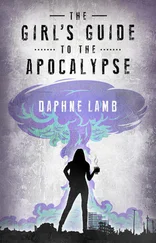Instantly, her printer light blinked. DMS had started the electrical pattern sequence again.
She ran the program again.
DMS started over again.
She ran the program a third time. And a third time her printer hummed. She ran the program a fourth time, thinking, “I’m talking to you. I’m responding to you. Do you know someone else is out here? Or is it like a toddler knocking something off a high chair just to see it fall?” The fourth time, there was no response. DMS didn’t start the sequence that should have started the lights going out at DM Kensington Medical but which would, in actual fact, simply send an alert to Damien and Sydney. DMS had responded three times and ignored it the fourth. She felt a chill.
Years later, she would tell about this moment. There really wasn’t enough proof to know that this wasn’t just an intermittent software glitch. But she had believed at that moment that this was proof. DMS was choosing to act or not act. Software didn’t choose. It ran. She would give talks and lectures and would come back to this moment again and again until like a coin it had worn so smooth that she couldn’t actually feel anything about it. What should would never tell, and would eventually mostly forget, was how afraid she was.
“What the fuck are you doing?” Damien asked.
“It answered me,” Sydney said. She told him.
“It doesn’t mean anything,” Damien said.
“What are you talking about?” Tony asked.
“Damien thinks that DMS might be aware,” Sydney said.
“What the fuck?” Tony said. “I don’t have time for this. Are you screwing around with this system? This four-point-two-million-dollar system on which people’s lives depend?”
“I don’t really think that,” Damien said. “It was just kind of an idea to kick around, you know?” The look he shot Sydney was murderous.
“We’re going to have to go to backup. This is a mess,” Tony said. “Admin wants us to go back to when the system was stable. Damien, can you fly to Texas on Saturday?”
DMS wasn’t “in one place.” DMS was a complex system spread across multiple servers. Damien would end up spending the weekend in Texas, babysitting part of the reload.
Damien was looking at Sydney. She should have said, “We can’t.” She should have said, “It’s aware. It’s the only one of its kind.” She should have said a lot of things. Instead she looked at her desk.
“Yeah,” Damien said. “I can go. I’m racking up the comp time, Tony.”
Tony waved his hand in a “don’t talk about that now” way. “Sydney, can you write me a memo about the data corruption you’re finding?”
“I don’t know that it’s really data corruption,” Sydney said.
“I don’t want to hear any more about this DMS-is-alive crap.”
“I don’t mean—DAMBALLAH might be catching things I’m not catching. The whole point is that DAMBALLAH is sorting the data.”
“Yeah,” Tony said, not really listening. “Write that up, too.”
Somewhere, DMS sorted the data stream. She was pretty sure that the thing in the machine did not think someone was talking to it. Blind and deaf, DMS had tried to make something happen, and something else had happened. But ones and zeroes weren’t interesting enough for DMS to keep doing it. There would be no Helen Keller–at-the-well moment for DMS. No moment when DMS felt something out there in the void, talking to it, when DMS knew it was not alone. Sharks do not worry about others. They don’t care. DMS didn’t care, wasn’t alive. It was aware of something. Just not her.
Tony told them they would be working that weekend to do the reinstall from backup. Start figuring out what they needed to do.
It would be gone. No one would ever know that she had known, except Damien. Maybe. He certainly wasn’t likely to say, “Hey, there was this AI and we killed it.” No, he’d explain to her how it was never really alive, how it could be restarted, so it wasn’t exactly dead.
DMS was not a shark. She didn’t know what it was. Didn’t know how to think about it. It was as opaque as a stone. Did it even care if it was or was not? It had no survival instinct.
They started figuring out what data they wanted to backup before the reinstall.
It was a dicey thing. People’s lives couldn’t be trusted to DMS. But DMS was aware. But DMS couldn’t be downloaded to another machine and replaced with a back-up. DMS was a system, a bunch of programs and computers all tied together.
A couple of hours later, Sydney dug out the Wired magazine with the interview with the guy from MIT who thought some systems had become aware. She sat at her desk for a while. Then she called MIT. “I’d like to talk to Professor Ayrton Tavares, please.”
She was forwarded. “This is Kaleisha,” a voice said.
“Can I talk to Professor Tavares?” Sydney asked.
“He’s not available right now,” the woman said. “Can I take a message?”
Sydney thought about saying, “no.” She was going to get in trouble for this. Benevola. They weren’t in the business of protecting nascent AIs. They were supposed to manage hospitals. “I’m a computer tech working on a big system like the ones that Professor Tavares talked about in the Wired article.”
“Yes?” said the woman.
“I’m pretty sure I’ve got proof that our system is aware. Like the ones in the article. And they’re going to shut it down.”
In the end, they would shut the system down. Benevola would fire Sydney for divulging proprietary information. She would go to grad school for urban planning.
But at that moment, she hung up the phone and went to find Damien. DMS was still swimming in the data stream. The future was still probabilities, not actualities.
“Damien,” she said, “I called Ayrton Tavares.”
Damien said, “Who?” Not really paying attention. The name meant nothing to him.
“The AI guy. The one in the Wired article.”
The look Damien gave her was naked and exposed. Too late she remembered that she wasn’t supposed to know that Damien had found the article in Wired . Too late she realized that her whole relationship with Damien rested on the understanding that he was the guru, the smart one. He was Obi Wan. She was just a girl whom he could explain things to. She had known it all along, at some level, but this was the first time she’d forgotten to uphold her end of the bargain.
Maybe she thought for a moment that like DMS, she didn’t care. But of course, she did.
Four years later, Rochester Institute of Technology would build a system that simulated DMS’s environment and load DMS. Despite the differences between the original hardware and RIT’s simulation, DMS would come back as if no time had passed at all. At 3:17, DMS would try to run the lights.
In the beginning, there were only the three of them, and I had met them quite by accident. The man sitting in the prow of the skiff was a short, brown-haired Englishman. He was smiling in a self-deprecating way. He was hunched forward, and he looked a little gray. I thought he was scared but trying not to make a big deal out of it. I gathered he had been sick, although he didn’t say so directly. He looked a little like a refugee, I thought. It was some sort of thing about his heart, maybe? Not a heart attack, but perhaps angina. I was worried for him, and so was the red-haired woman he was with.
“You need to eat,” the red-haired woman said. “Have another one of the granola bars.” She was direct and not sentimental. She didn’t fuss. They didn’t talk much.
“How long have you lived in the States?” I asked the Englishman.
“Eighteen years,” he said. “My family says I sound like an American.”
Читать дальше












